The Arctic
The Arctic culture area, a cold, flat, treeless region (actually a frozen desert) near the Arctic Circle in present-day Alaska, Canada and Greenland, was home to the Inuit and the Aleut. Both groups spoke, and continue to speak, dialects descended from what scholars call the Eskimo-Aleut language family. Because it is such an inhospitable landscape, the Arctic’s population was comparatively small and scattered. Some of its peoples, especially the Inuit in the northern part of the region, were nomads, following seals, polar bears and other game as they migrated across the tundra. In the southern part of the region, the Aleut were a bit more settled, living in small fishing villages along the shore.
The Inuit and Aleut had a great deal in common. Many lived in dome-shaped houses made of sod or timber (or, in the North, ice blocks). They used seal and otter skins to make warm, weatherproof clothing, aerodynamic dogsleds and long, open fishing boats (kayaks in Inuit; baidarkas in Aleut).
By the time the United States purchased Alaska in 1867, decades of oppression and exposure to European diseases had taken their toll: The native population had dropped to just 2,500; the descendants of these survivors still make their home in the area today.
The Subarctic
The Subarctic culture area, mostly composed of swampy, piney forests (taiga) and waterlogged tundra, stretched across much of inland Alaska and Canada. Scholars have divided the region’s people into two language groups: the Athabaskan speakers at its western end, among them the Tsattine (Beaver), Gwich’in (or Kuchin) and the Deg Xinag (formerly—and pejoratively—known as the Ingalik), and the Algonquian speakers at its eastern end, including the Cree, the Ojibwa and the Naskapi.
In the Subarctic, travel was difficult—toboggans, snowshoes and lightweight canoes were the primary means of transportation—and population was sparse. In general, the peoples of the Subarctic did not form large permanent settlements; instead, small family groups stuck together as they traipsed after herds of caribou. They lived in small, easy-to-move tents and lean-tos, and when it grew too cold to hunt they hunkered into underground dugouts.
The growth of the fur trade in the 17th and 18th centuries disrupted the Subarctic way of life—now, instead of hunting and gathering for subsistence, the Indians focused on supplying pelts to the European traders—and eventually led to the displacement and extermination of many of the region’s native communities.
The Northeast
The Northeast culture area, one of the first to have sustained contact with Europeans, stretched from present-day Canada’s Atlantic coast to North Carolina and inland to the Mississippi River valley. Its inhabitants were members of two main groups: Iroquoian speakers (these included the Cayuga, Oneida, Erie, Onondaga, Seneca and Tuscarora), most of whom lived along inland rivers and lakes in fortified, politically stable villages, and the more numerous Algonquian speakers (these included the Pequot, Fox, Shawnee, Wampanoag, Delaware and Menominee) who lived in small farming and fishing villages along the ocean. There, they grew crops like corn, beans and vegetables.
Life in the Northeast culture area was already fraught with conflict—the Iroquoian groups tended to be rather aggressive and warlike, and bands and villages outside of their allied confederacies were never safe from their raids—and it grew more complicated when European colonizers arrived. Colonial wars repeatedly forced the region’s natives to take sides, pitting the Iroquois groups against their Algonquian neighbors. Meanwhile, as white settlement pressed westward, it eventually displaced both sets of indigenous people from their lands.
The Southeast
The Southeast culture area, north of the Gulf of Mexico and south of the Northeast, was a humid, fertile agricultural region. Many of its natives were expert farmers—they grew staple crops like maize, beans, squash, tobacco and sunflower—who organized their lives around small ceremonial and market villages known as hamlets. Perhaps the most familiar of the Southeastern indigenous peoples are the Cherokee, Chickasaw, Choctaw, Creek and Seminole, sometimes called the Five Civilized Tribes, who all spoke a variant of the Muskogean language.
By the time the U.S. had won its independence from Britain, the Southeast culture area had already lost many of its native people to disease and displacement. In 1830, the federal Indian Removal Act compelled the relocation of what remained of the Five Civilized Tribes so that white settlers could have their land. Between 1830 and 1838, federal officials forced nearly 100,000 Indians out of the southern states and into “Indian Territory” (later Oklahoma) west of the Mississippi. The Cherokee called this frequently deadly trek the Trail of Tears.
The Plains
The Plains culture area comprises the vast prairie region between the Mississippi River and the Rocky Mountains, from present-day Canada to the Gulf of Mexico. Before the arrival of European traders and explorers, its inhabitants—speakers of Siouan, Algonquian, Caddoan, Uto-Aztecan and Athabaskan languages—were relatively settled hunters and farmers. After European contact, and especially after Spanish colonists brought horses to the region in the 18th century, the peoples of the Great Plains became much more nomadic. Groups like the Crow, Blackfeet, Cheyenne, Comanche and Arapaho used horses to pursue great herds of buffalo across the prairie. The most common dwelling for these hunters was the cone-shaped teepee, a bison-skin tent that could be folded up and carried anywhere. Plains Indians are also known for their elaborately feathered war bonnets.
As white traders and settlers moved west across the Plains region, they brought many damaging things with them: commercial goods, like knives and kettles, which native people came to depend on; guns; and disease. By the end of the 19th century, white sport hunters had nearly exterminated the area’s buffalo herds. With settlers encroaching on their lands and no way to make money, the Plains natives were forced onto government reservations.
The Southwest
The peoples of the Southwest culture area, a huge desert region in present-day Arizona and New Mexico (along with parts of Colorado, Utah, Texas and Mexico) developed two distinct ways of life.
Sedentary farmers such as the Hopi, the Zuni, the Yaqui and the Yuma grew crops like corn, beans and squash. Many lived in permanent settlements, known as pueblos, built of stone and adobe. These pueblos featured great multistory dwellings that resembled apartment houses. At their centers, many of these villages also had large ceremonial pit houses, or kivas.
Other Southwestern peoples, such as the Navajo and the Apache, were more nomadic. They survived by hunting, gathering and raiding their more established neighbors for their crops. Because these groups were always on the move, their homes were much less permanent than the pueblos. For instance, the Navajo fashioned their iconic eastward-facing round houses, known as hogans, out of materials like mud and bark.
By the time the southwestern territories became a part of the United States after the Mexican War, many of the region’s native people had already been exterminated. (Spanish colonists and missionaries had enslaved many of the Pueblo Indians, for example, working them to death on vast Spanish ranches known as encomiendas.) During the second half of the 19th century, the federal government resettled most of the region’s remaining natives onto reservations.
The Great Basin
The Great Basin culture area, an expansive bowl formed by the Rocky Mountains to the east, the Sierra Nevadas to the west, the Columbia Plateau to the north, and the Colorado Plateau to the south, was a barren wasteland of deserts, salt flats and brackish lakes. Its people, most of whom spoke Shoshonean or Uto-Aztecan dialects (the Bannock, Paiute and Ute, for example), foraged for roots, seeds and nuts and hunted snakes, lizards and small mammals. Because they were always on the move, they lived in compact, easy-to-build wikiups made of willow poles or saplings, leaves and brush. Their settlements and social groups were impermanent, and communal leadership (what little there was) was informal.
After European contact, some Great Basin groups got horses and formed equestrian hunting and raiding bands that were similar to the ones we associate with the Great Plains natives. After white prospectors discovered gold and silver in the region in the mid-19th century, most of the Great Basin’s people lost their land and, frequently, their lives.
California
Before European contact, the temperate, hospitable California culture area had more people—an estimated 300,000 in the mid-16th century—than any other. It was also more diverse: Its estimated 100 different tribes and groups spoke more spoke more than 200 dialects. (These languages derived from the Penutian (the Maidu, Miwok and Yokuts), the Hokan (the Chumash, Pomo, Salinas and Shasta), the Uto-Aztecan (the Tubabulabal, Serrano and Kinatemuk; also, many of the “Mission Indians” who had been driven out of the Southwest by Spanish colonization spoke Uto-Aztecan dialects) and Athapaskan (the Hupa, among others). In fact, as one scholar has pointed out, California’s linguistic landscape was more complex than that of Europe.
Despite this great diversity, many native Californians lived very similar lives. They did not practice much agriculture. Instead, they organized themselves into small, family-based bands of hunter-gatherers known as tribelets. Inter-tribelet relationships, based on well-established systems of trade and common rights, were generally peaceful.
Spanish explorers infiltrated the California region in the middle of the 16th century. In 1769, the cleric Junipero Serra established a mission at San Diego, inaugurating a particularly brutal period in which forced labor, disease and assimilation nearly exterminated the culture area’s native population.
The Northwest Coast
The Northwest Coast culture area, along the Pacific coast from Britfashioninn4us.blogspot.comish Columbia to the top of Northern California, has a mild climate and an abundance of natural resources. In particular, the ocean and the region’s rivers provided almost everything its people needed—salmon, especially, but also whales, sea otters, seals and fish and shellfish of all kinds. As a result, unlike many other hunter-gatherers who struggled to eke out a living and were forced to follow animal herds from place to place, the Indians of the Pacific Northwest were secure enough to build permanent villages that housed hundreds of people apiece. Those villages operated according to a rigidly stratified social structure, more sophisticated than any outside of Mexico and Central America. A person’s status was determined by his closeness to the village’s chief and reinforced by the number of possessions—blankets, shells and skins, canoes and even slaves—he had at his disposal. (Goods like these played an important role in the potlatch, an elaborate gift-giving ceremony designed to affirm these class divisions.)
Prominent groups in the region included the Athapaskan Haida and Tlingit; the Penutian Chinook, Tsimshian and Coos; the Wakashan Kwakiutl and Nuu-chah-nulth (Nootka); and the Salishan Coast Salish.
The Plateau
The Plateau culture area sat in the Columbia and Fraser river basins at the intersection of the Subarctic, the Plains, the Great Basin, the California and the Northwest Coast (present-day Idaho, Montana and eastern Oregon and Washington). Most of its people lived in small, peaceful villages along stream and riverbanks and survived by fishing for salmon and trout, hunting and gathering wild berries, roots and nuts. In the southern Plateau region, the great majority spoke languages derived from the Penutian (the Klamath, Klikitat, Modoc, Nez Perce, Walla Walla and Yakima or Yakama). North of the Columbia River, most (the Skitswish (Coeur d’Alene), Salish (Flathead), Spokane and Columbia) spoke Salishan dialects.
In the 18th century, other native groups brought horses to the Plateau. The region’s inhabitants quickly integrated the animals into their economy, expanding the radius of their hunts and acting as traders and emissaries between the Northwest and the Plains. In 1805, the explorers Lewis and Clark passed through the area, drawing increasing numbers of disease-spreading white settlers. By the end of the 19th century, most of the remaining Plateau Indians had been cleared from their lands and resettled in government reservations.
Scenes from India
India is home to over 1.2 billion people of wildly varying religions, cultures and levels of wealth. Only 61 years since declaring its Independence from English rule, modern India is still defining itself, sometimes against the friction inside and outside of its borders. Recent newsworthy events in India include vast Monsoon flooding, conflicts in still-disputed Kashmir, and religious clashes between Hindus and Christians - and celebrations conducted by Hindu, Muslim, Christian, Sikh and more. Though there's no possible way for these images to be comprehensive, here are some recent photos of scenes in India. (34 photos total)
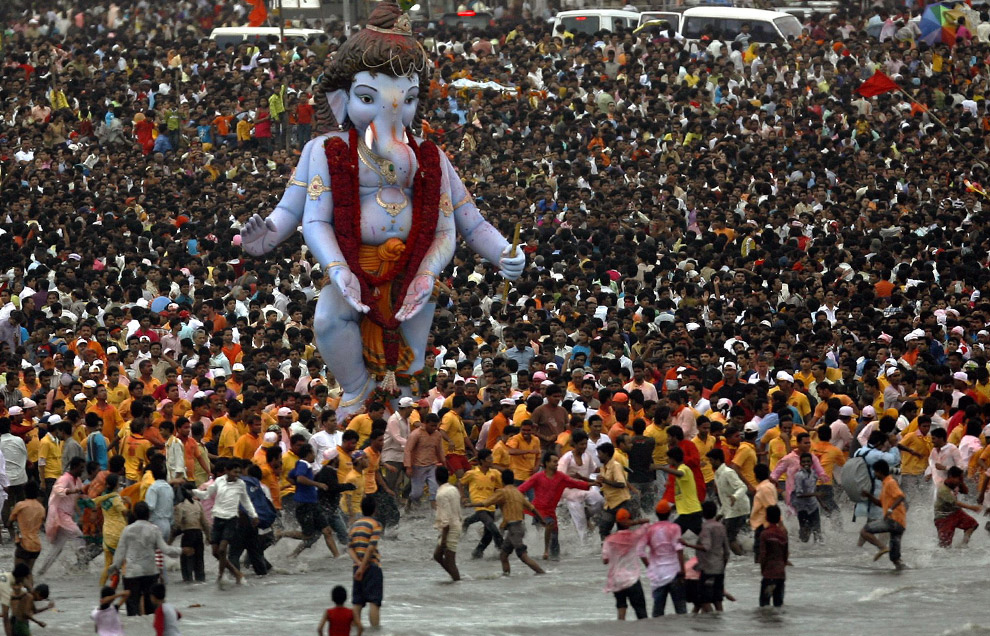
Devotees carry a statue of the Hindu elephant god Ganesh, the deity of prosperity, for immersion in the sea, on the last day of "Ganesh Chaturthi", in Mumbai September 14, 2008. Clay statues of Ganesh are made two to three months before this popular religious festival in India. The idols are taken through the streets in a procession accompanied with dancing and singing, to be immersed in a river symbolizing a ritual sendoff on his journey towards his home. (REUTERS/Punit Paranjpe)
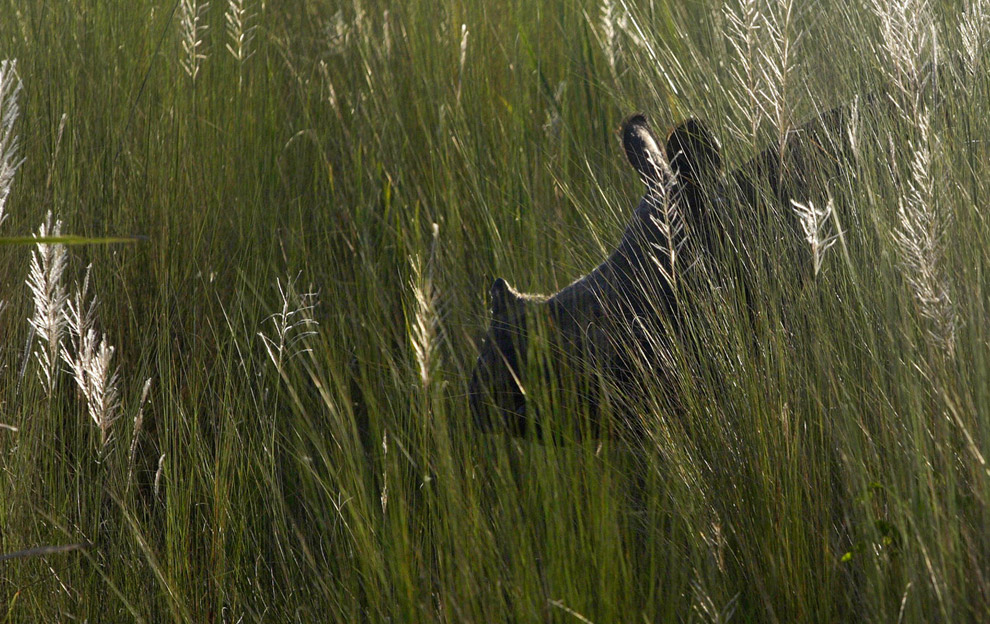
A rhinoceros which strayed in Kalcheni village, about 130 kilometers (81 miles) west of Gauhati, India, Sunday, Sept. 14, 2008, hides from wildlife officials. More than 100 wildlife officials tracked the animal using its radio collar after it strayed from the Assam state's Manas National Park on Sept. 1, but could not capture it until Sunday, fearing that if they tranquilized it in the marshy area it could drown. (AP Photo/Anupam Nath) #
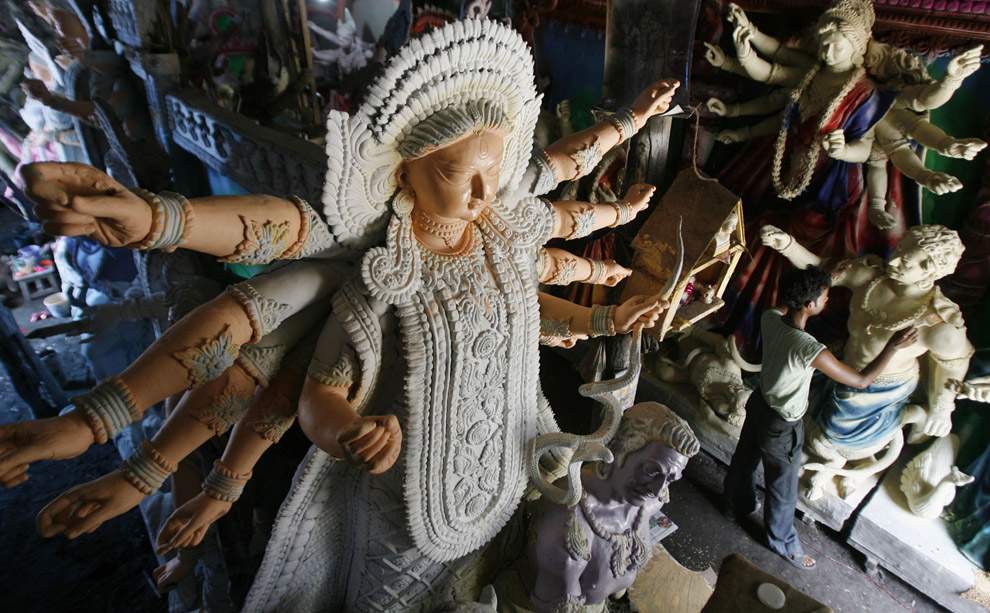
An artisan gives finishing touches to an idol of the Hindu Goddess Durga at a workshop in the northeastern Indian city of Siliguri September 20, 2008. The idols will be used during the Durga Puja festival, a popular religious event for Hindu Bengalis. In Hindu mythology, Durga symbolises power and the triumph of good over evil. (REUTERS/Rupak De Chowdhuri) #
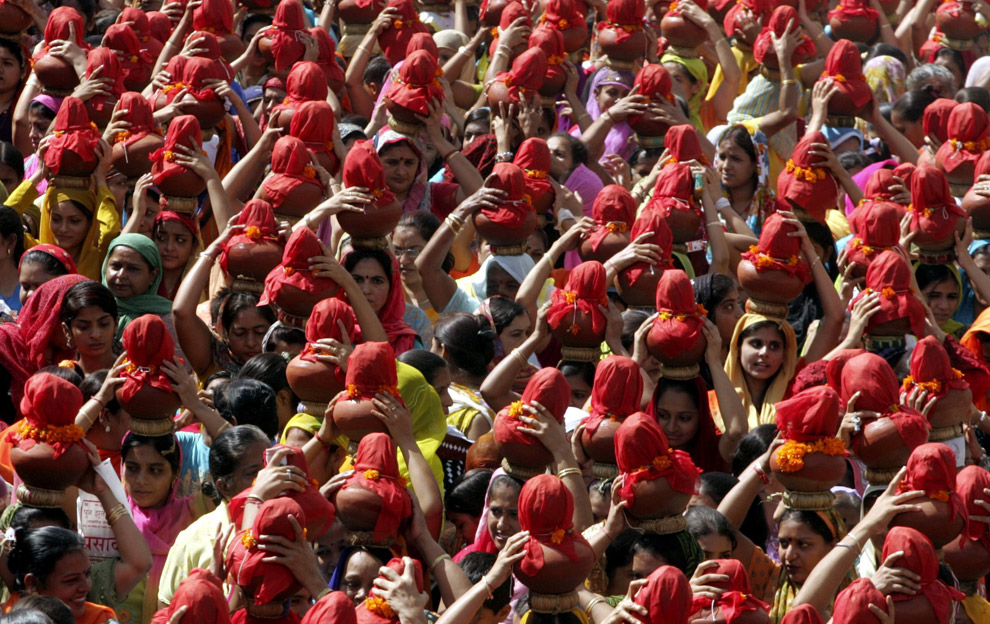
People carry earthen water pots as they take part in a Jhulelal Chaliha procession in the western Indian city of Ahmedabad September 6, 2008. Thousands of people took part in the 40 day long fasting festival of the Sindhi community, Jhulelal Chaliha, that ended on Saturday with a colourful procession of earthen pots carried by male and female devotees on their heads. (REUTERS/Amit Dave) #
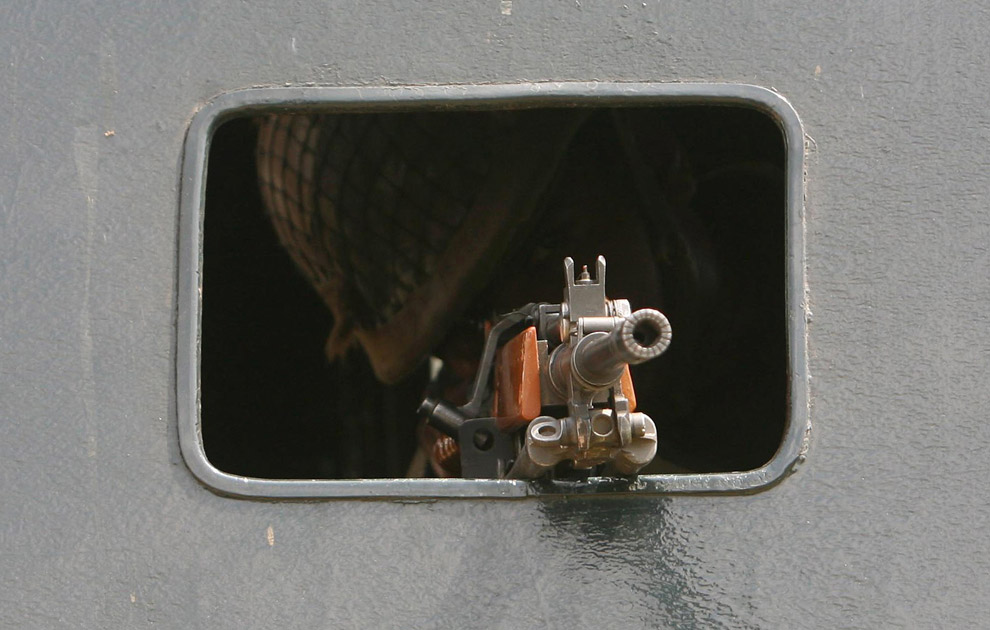
An Indian Border Security Force (BSF) soldier holds position inside a bulletproof vehicle during an encounter at Chinor village on the outskirts of Jammu August 27, 2008. Suspected Muslim militants who slipped across the border from Pakistan into Indian Kashmir killed at least two civilians and an army officer in the Hindu-majority region of Jammu earlier that day, police said. (REUTERS/Amit Gupta) #
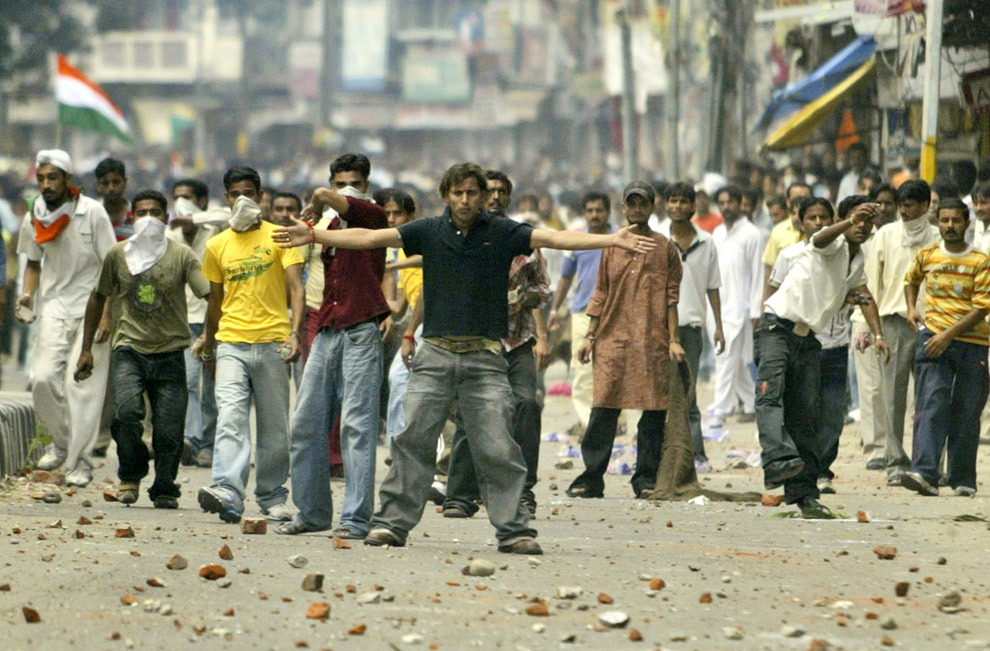
Protestors challenge the police during a victory rally in Jammu, India, Sunday, Aug. 31, 2008. Hindus on Sunday suspended their two-month-old protest over allotment of land to a Hindu trust to build facilities for pilgrims in the Indian portion of Kashmir, which had triggered some of the worst violence in the region in more than a decade, officials said. (AP Photo/Channi Anand) #
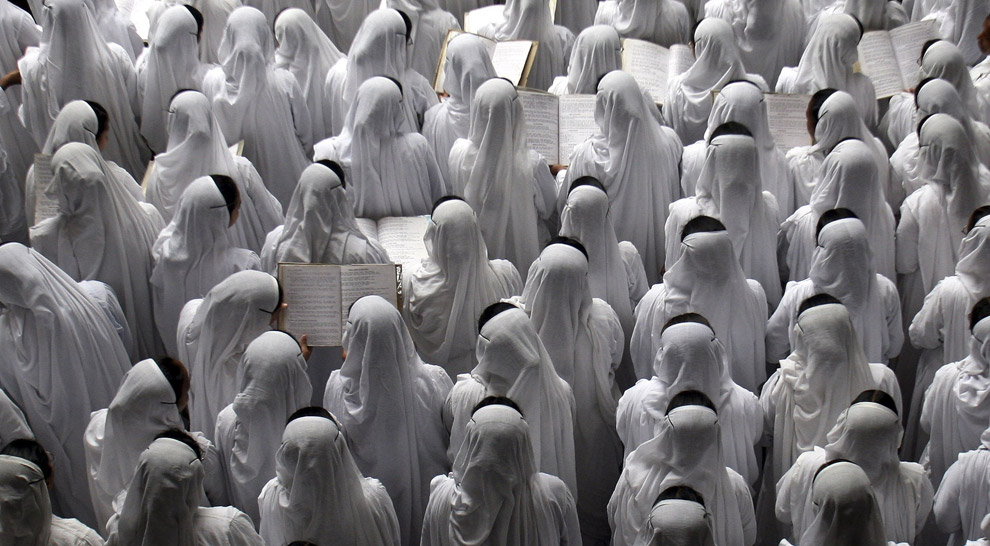
Catholic nuns from the Missionaries of Charity order sing hymns for a special prayer during the eleventh anniversary of the death of Mother Teresa in the eastern Indian city of Kolkata September 5, 2008. Mother Teresa was a Nobel Peace Prize-winning nun who died in 1997, and was beatified by Pope John Paul II in 2003 at the Vatican. (REUTERS/Jayanta Shaw) #
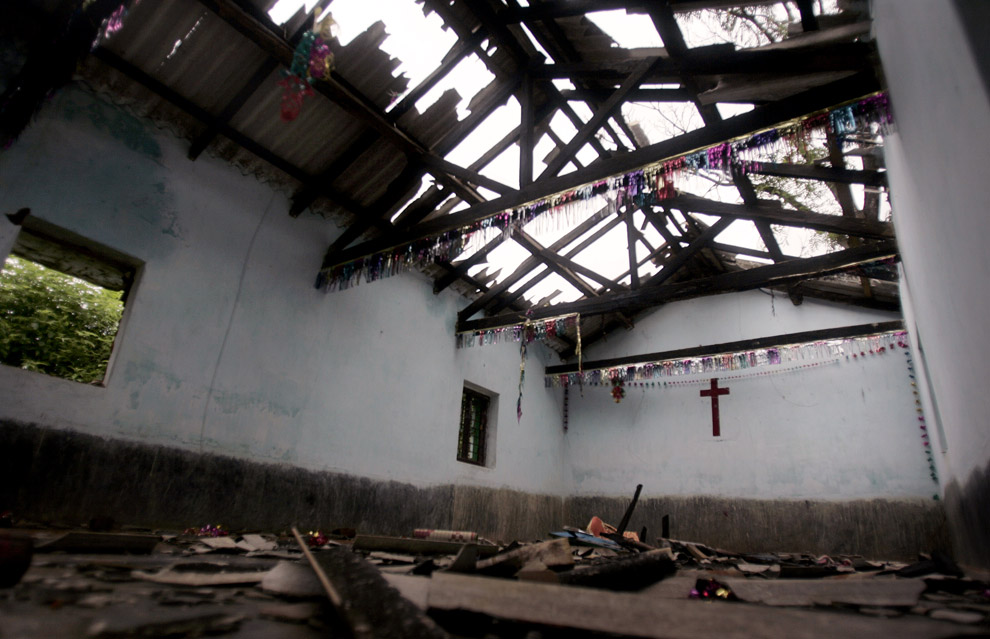
A damaged church, seen in the village of Raikia, India, after it was allegedly stormed by Hindu fundamentalists, on August 31, 2008. Indian authorities insisted they had halted deadly clashes between Hindus and Christians in the east of the country that have exposed it to stinging criticism. At least 10 people have died and thousands have fled their homes as a result of the violence in the coastal state of Orissa, with the Catholic church accusing police of failing to protect defenceless priests and nuns. (DESHAKALYAN CHOWDHURY/AFP/Getty Images) #

A Theyyam dancer waits to perform during festivities marking the start of the annual harvest festival of "Onam" in the southern Indian city of Kochi September 2, 2008. The 10-day long festival is celebrated annually in India's southern coastal state of Kerala to symbolise the return of King Mahabali to meet his beloved subjects. (REUTERS/Sivaram V) #
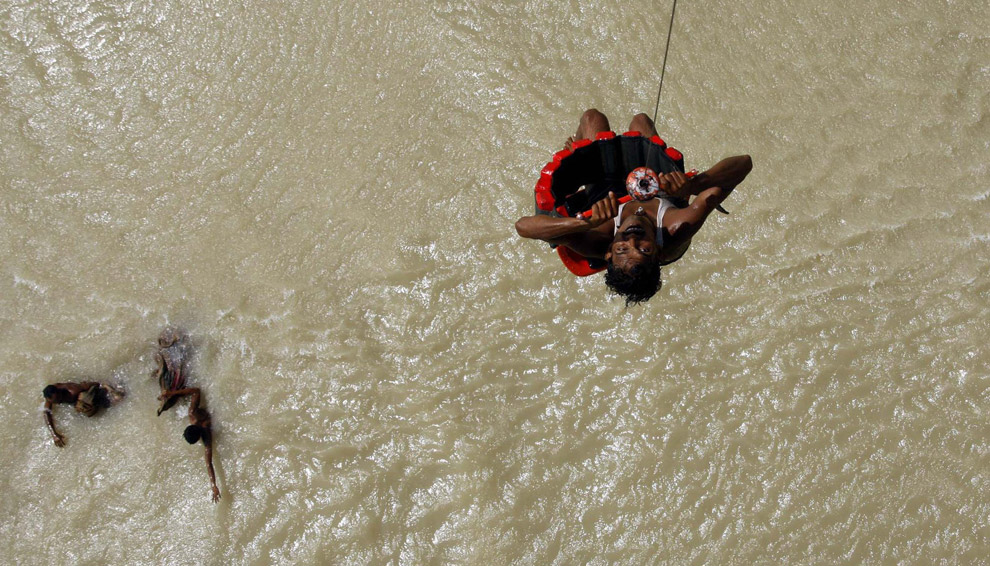
A man is airlifted onto an Indian Air Force helicopter at a flood-affected village in the eastern Indian state of Bihar September 3, 2008. The floods have forced more than three million people from their homes, destroyed 250,000 acres of farmland and killed over 150 people. (REUTERS/Indian Defence Ministry) #

A flood-affected man waits for food in a flood relief camp at Jankinagar village of Purniya district in the eastern Indian state of Bihar, September 6, 2008. Authorities battling a massive deluge in Bihar had issued public warnings of more floods to come and asked villagers not to return home from temporary shelters yet. (REUTERS/Rupak De Chowdhuri) #
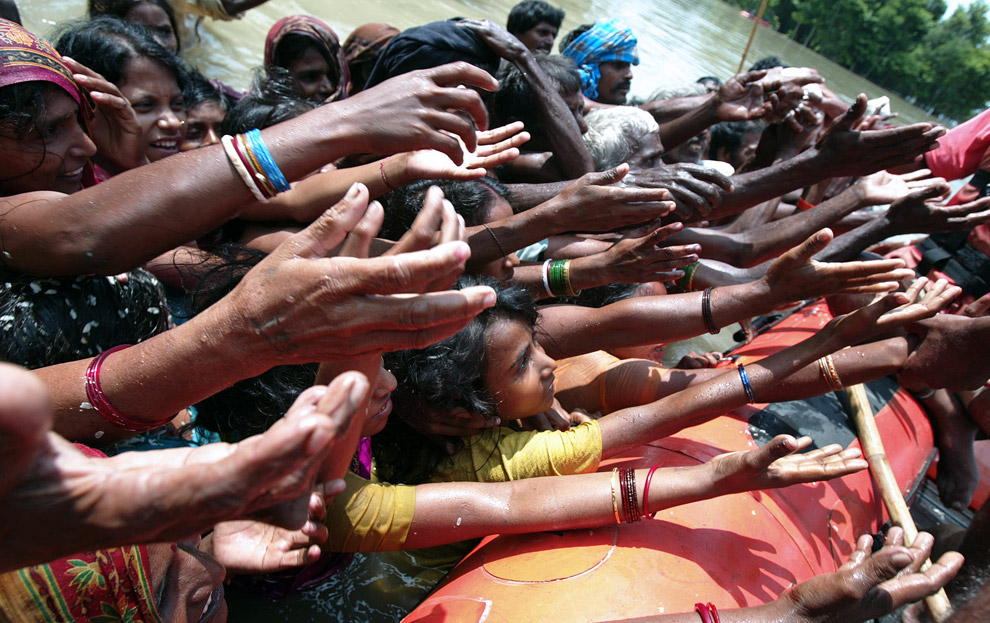
Refugees from flooded areas extend their hands to fetch food packets distributed by National Disaster Relief Force (NDRF) personnel at Raghunathpur area, Madhepura district of India's northeastern state of Bihar, on September 5, 2008. Rescue workers in flood-hit northern India have brought over 800,000 people to safety, but tens of thousands more were still believed to be trapped, officials said. (DIPTENDU DUTTA/AFP/Getty Images) #

Forestry workers look on as a male Royal Bengal Tiger leaps off a boat into the water after being released back into the wild in The Chamta Forest District of The Sunderbans, in India, on September 4, 2008. The tiger was declared fit for release by veterinarians after it was recently rescued from a nearby village. (HO/AFP/Getty Images) #
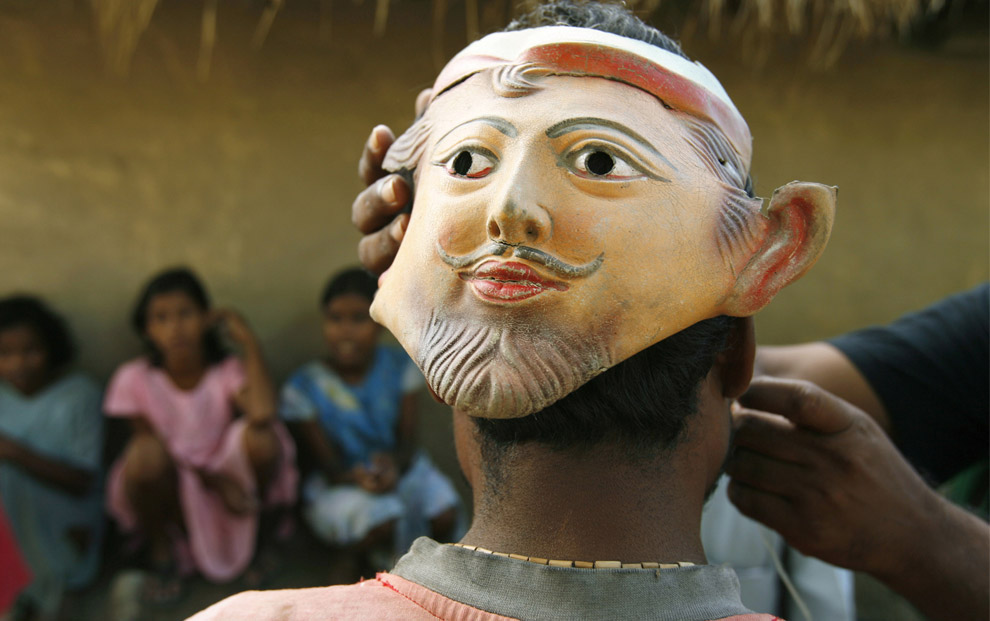
A mask is shown being put on the back of honey collector Madhusudhan Mondal's head, in Bali, a village in the Sundarbans, India, Tuesday, Aug. 5, 2008. The Sundarbans forest, a remote tangle of unforgiving islands dangling off the eastern edge of India, is home to perhaps the world's largest population of tigers, prone to attacking humans, as well as 4 million people who are among the poorest in India. Locals believe that tigers do not attack humans from the front and wear masks on the back of their heads in the hope of warding them off. (AP Photo/Gautam Singh) #
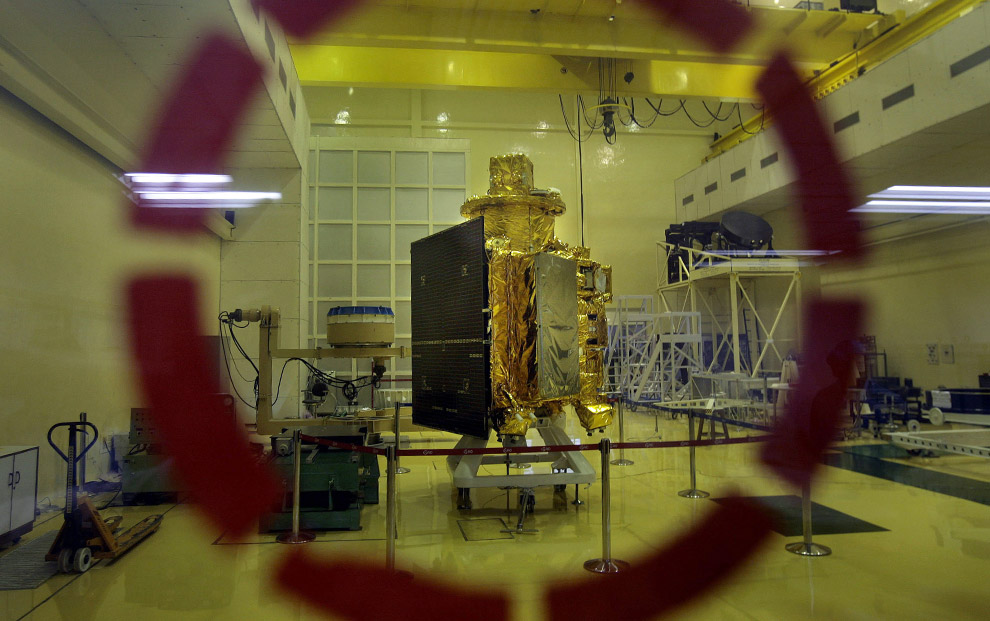
The Satellite Chandrayaan-1 spacecraft, India's first moon mission craft is seen from behind glass at the Indian Space Research Organisation (ISRO) center in Bangalore on September 18, 2008. Chandrayaan-1, which has almost reached its final stages of preparation before its shipment to its launch centre at the Satish Dhawan Space Centre (SHAR), in Sriharikota.(DIBYANGSHU SARKAR/AFP/Getty Images) #
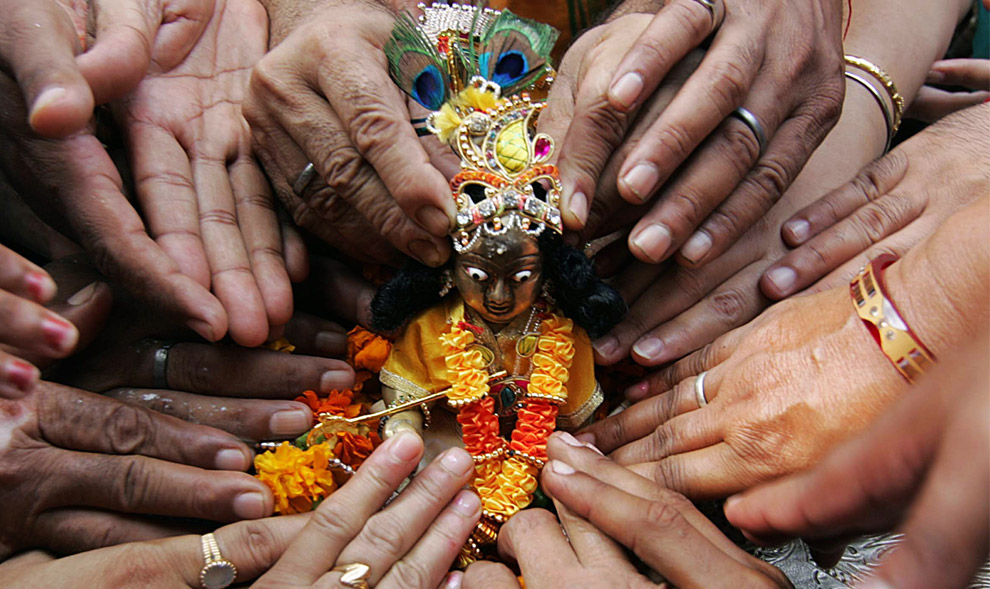
Indian Hindu devotees pay their respects after pouring milk water onto an idol of Hindu God Lord Krishna at the Shivala temple in Amritsar, on August 24, 2008, on the occasion of the "Janmashtami" festival, which marks the birth of Lord Krishna. Devotional songs and dances mark the celebrations of the festival all over northern India. (NARINDER NANU/AFP/Getty Images) #
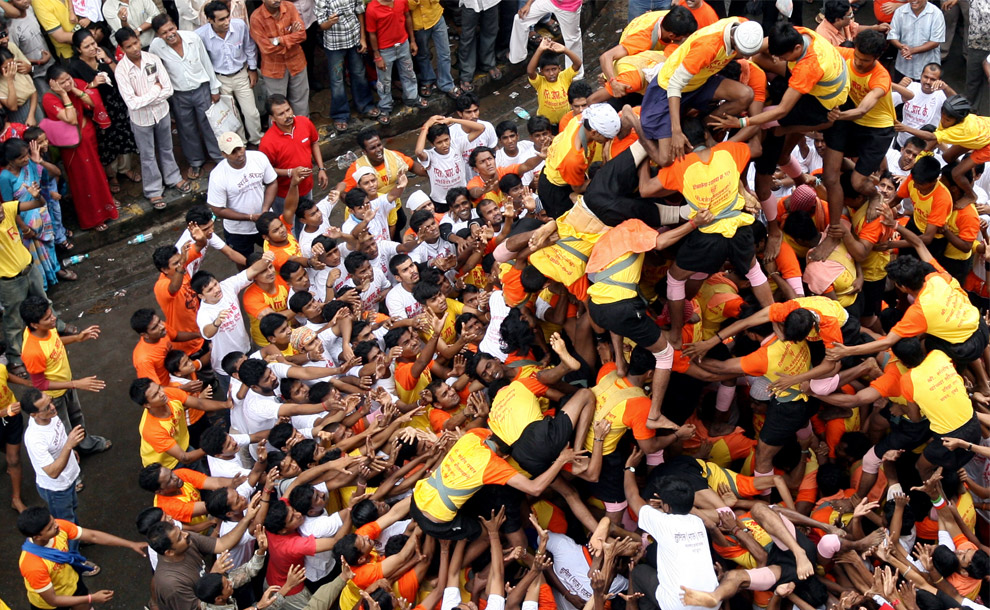
Young Indian devotees of Hindu God Lord Krishna attempt to make a seven-tier human pyramid in the 'dahi-handi' (curd-pot) contest in Mumbai on August 24, 2008, as part of celebrations of "Janmashtami" which marks the birth of Hindu God Lord Krishna. Scores of Hindu devotees of Lord Krishna partake in the dahi-handi celebration during which a large earthenware pot is filled with milk, curds, butter, honey and fruits and suspended from a height of between 20 to 40 feet. Sporting young men and boys come forward to claim this prize by constructing a human pyramid till the pyramid is tall enough to enable the topmost person to reach the pot and claim the contents after breaking it. (PAL PILLAI/AFP/Getty Images) #
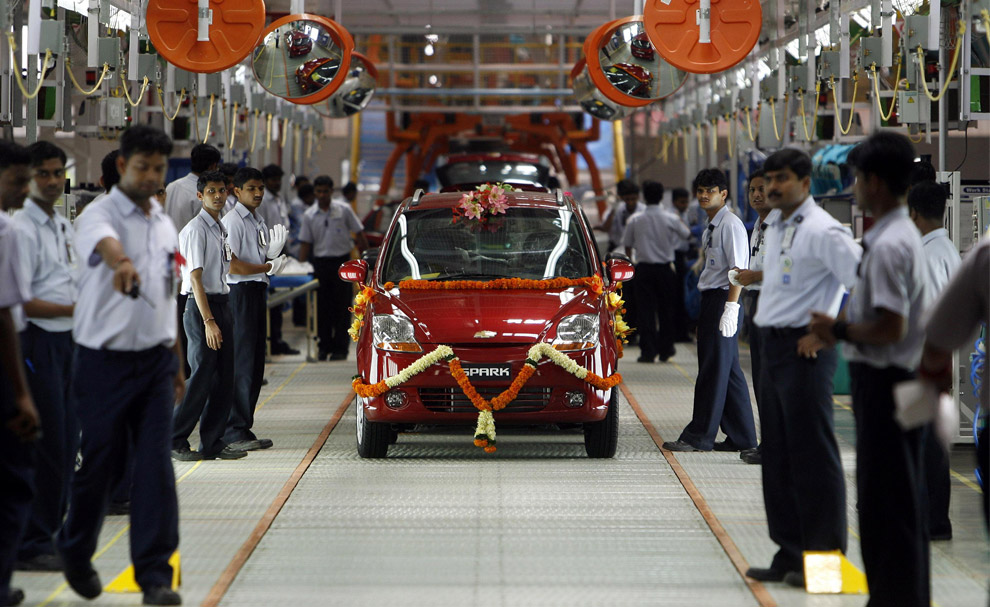
Engineers prepare to roll-out the Spark, one of General Motors Corp's passenger vehicles, at the company's new plant in Talegaon, about 160 km (99 miles) northeast of Mumbai September 2, 2008. General Motors Corp's most important priority is to turn around its North American business and it will continue investments in emerging markets, its chief operating officer said on Tuesday. (REUTERS/Punit Paranjpe) #
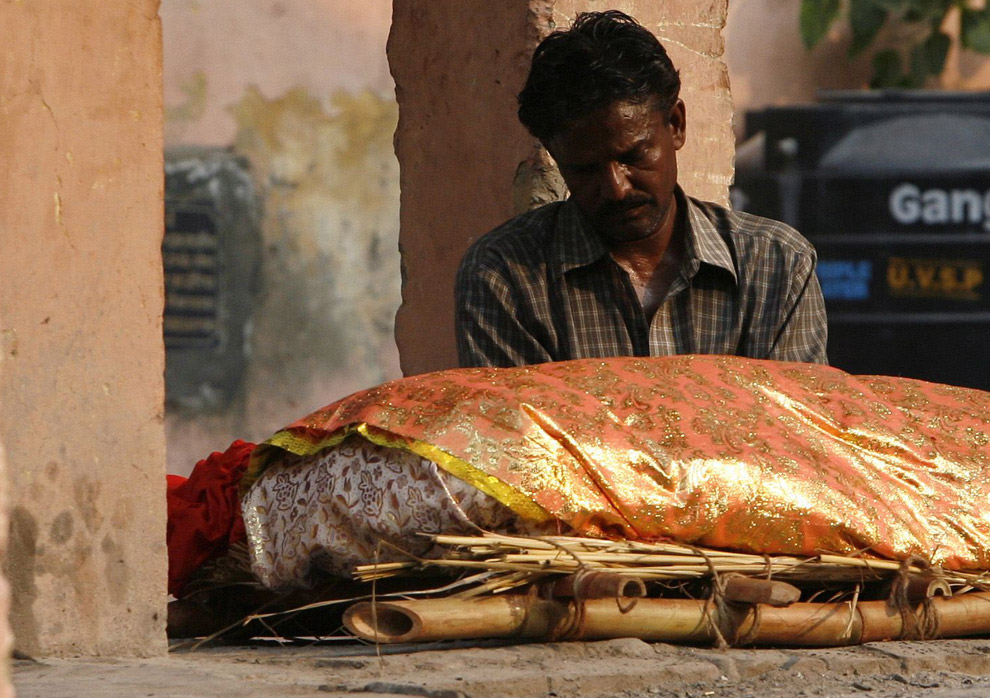
A relative of a bomb blast victim sits next to their body at a cremation ground in New Delhi September 14, 2008. Police officers trawled slums and criminal hideouts in India's capital on Sunday rounding up suspects after serial bombings in the city a day earlier killed at least 21 people and wounded nearly 100. At least five bombs exploded in quick succession in crowded markets and streets in the heart of New Delhi on Saturday night. (REUTERS/Adnan Abidi) #
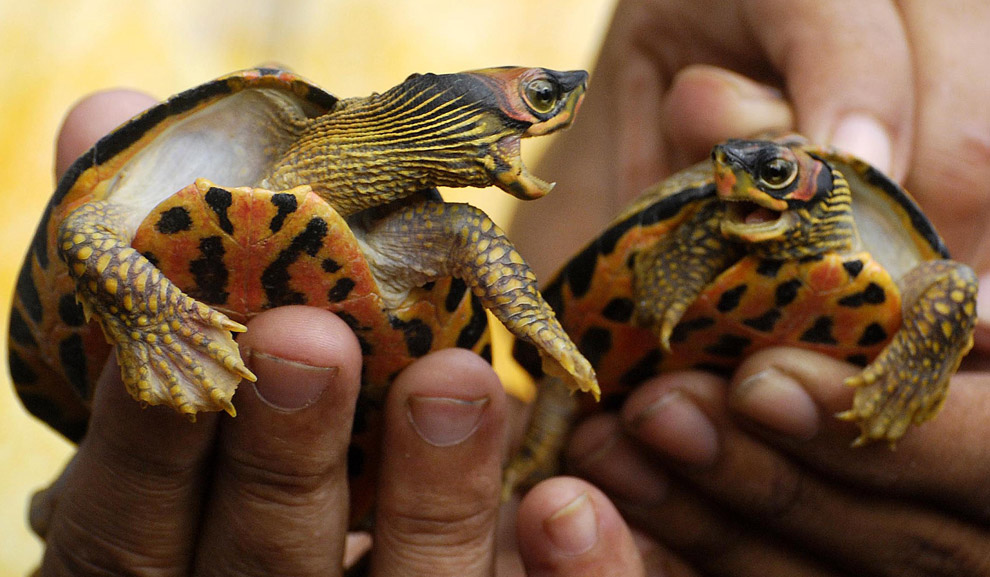
Activists of the People for Animals (PFA) an NGO hold two Dwarf tortoises, which were rescued from a resident in Guwahati on September 18, 2008. The pair were later released into the the Dighalipukhuri pond in Guwahati, the capital city of India’s northeastern state of Assam. (BIJU BORO/AFP/Getty Images) #

People fish for wood for domestic use at the Naraj barrage on the Kathjodi River in the eastern Indian state of Orissa, Friday, Sept. 19, 2008. The flood situation in Orissa worsened as the government launched a massive evacuation operation to shift the residents of low-lying areas to safer places, according to a news agency. (AP Photo/Biswaranjan Rout) #
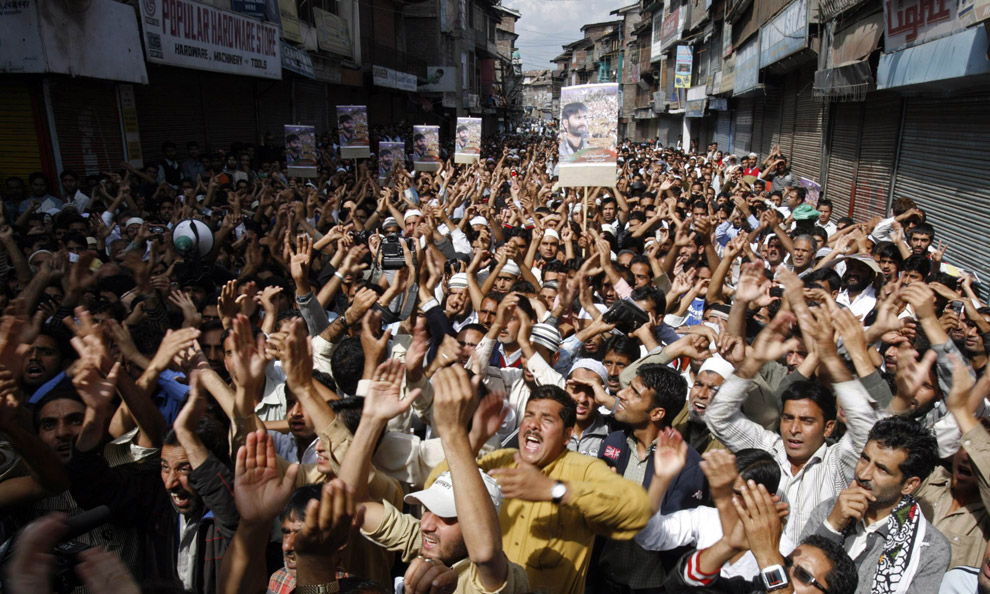
Kashmiri Muslim protesters shout pro-freedom slogans during an anti-India protest in Srinagar September 19, 2008. Thousands of Muslims demonstrators shouting anti-India slogans took to streets in Kashmir's main city on Friday and resumed protests against New Delhi's rule in the disputed region. (REUTERS/Fayaz Kabli) #
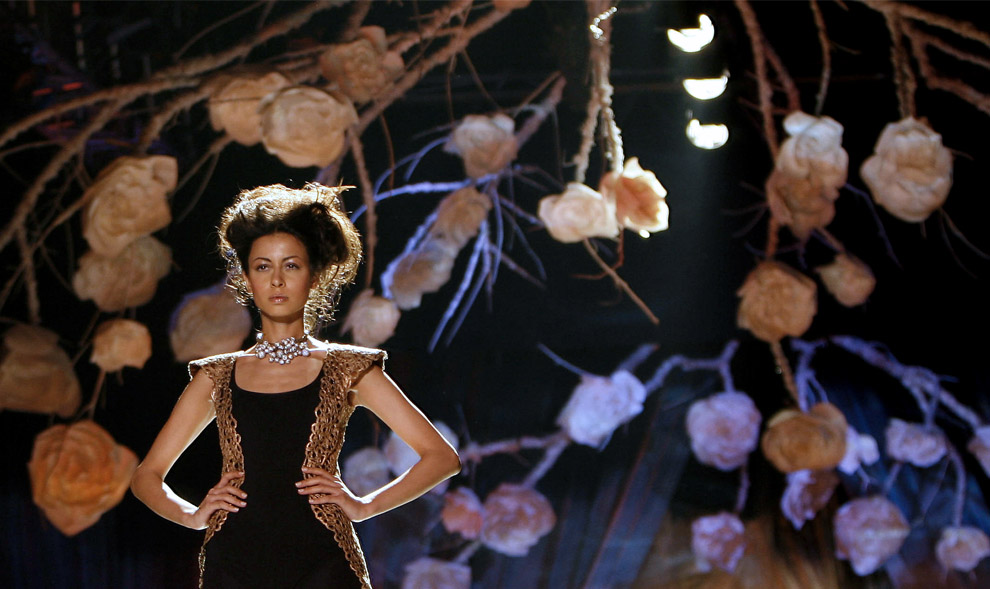
A model presents a creation by Indian designer Anamika Khanna on the fourth day of the HDIL India Couture Week in Mumbai on September 19, 2008. India is hosting its first ever haute couture week showcasing over six days, 11 leading designers in a celebration of the country's rich heritage in bespoke fashion. But unlike the bank-breaking, impossible-to-wear creations on show twice a year in Paris that are not even intended for the high street, Indian couturiers say they are offering wearable made-to-order clothes at a realistic price. (SAJJAD HUSSAIN/AFP/Getty Images) #

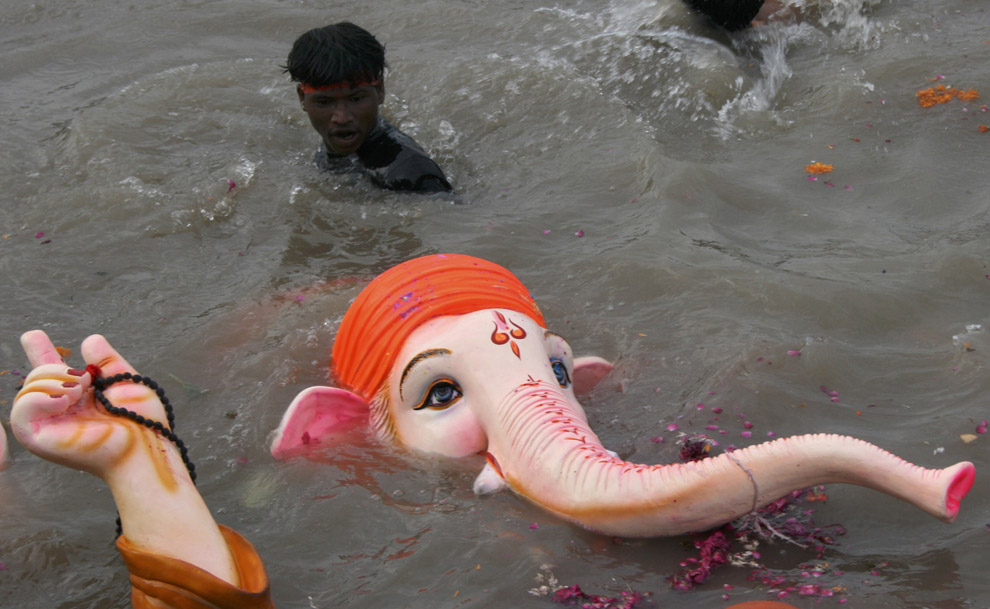
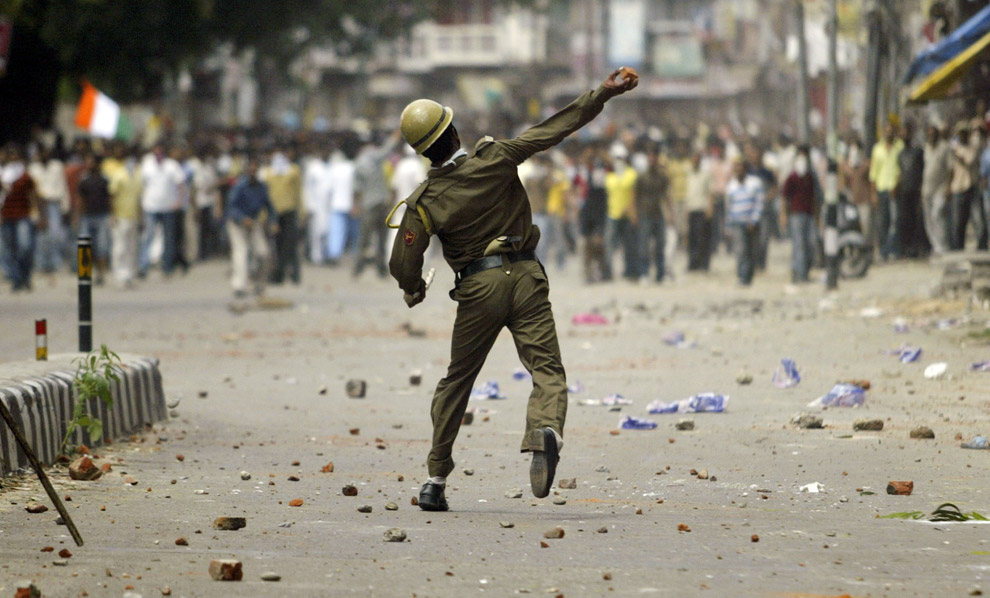
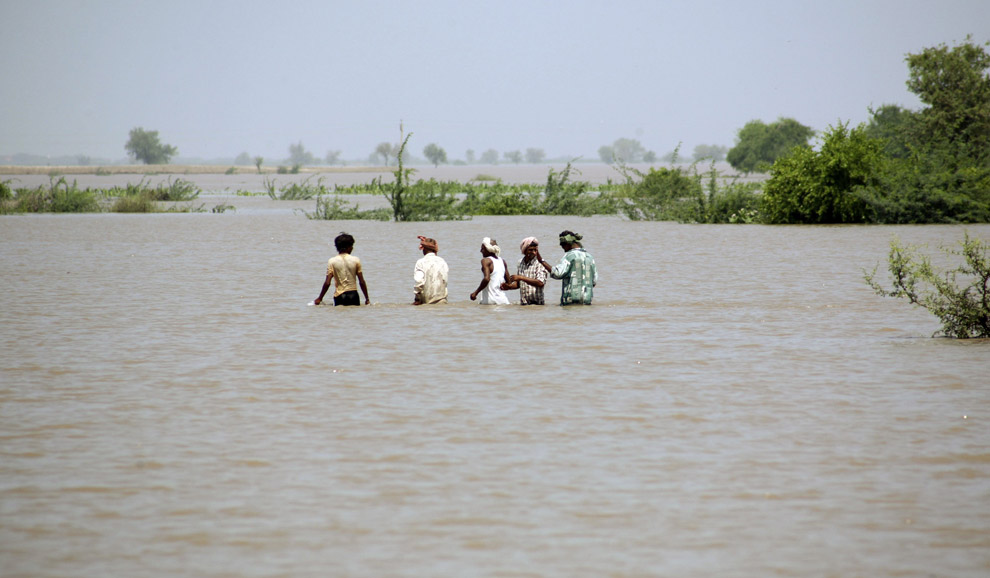
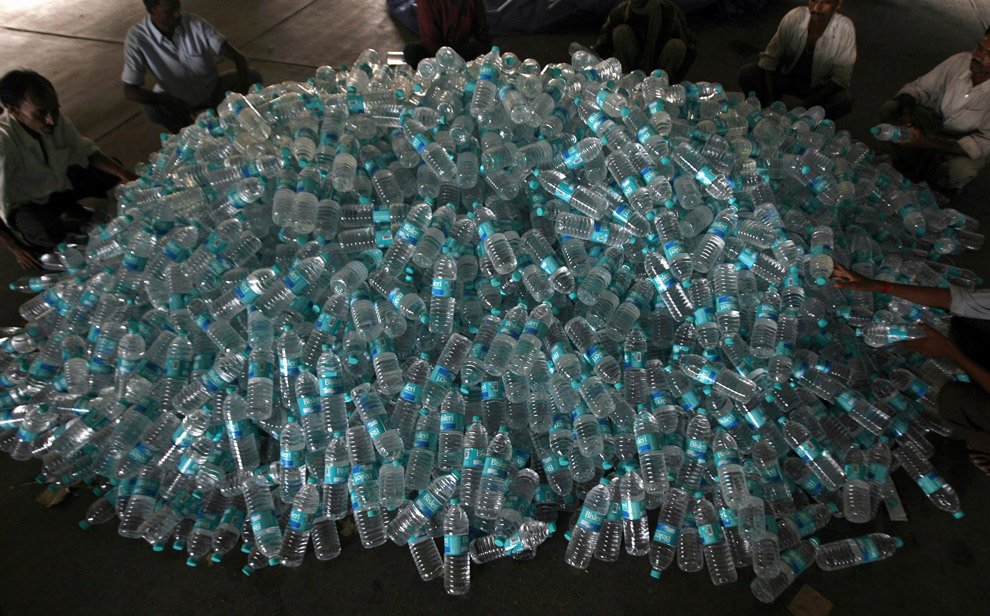
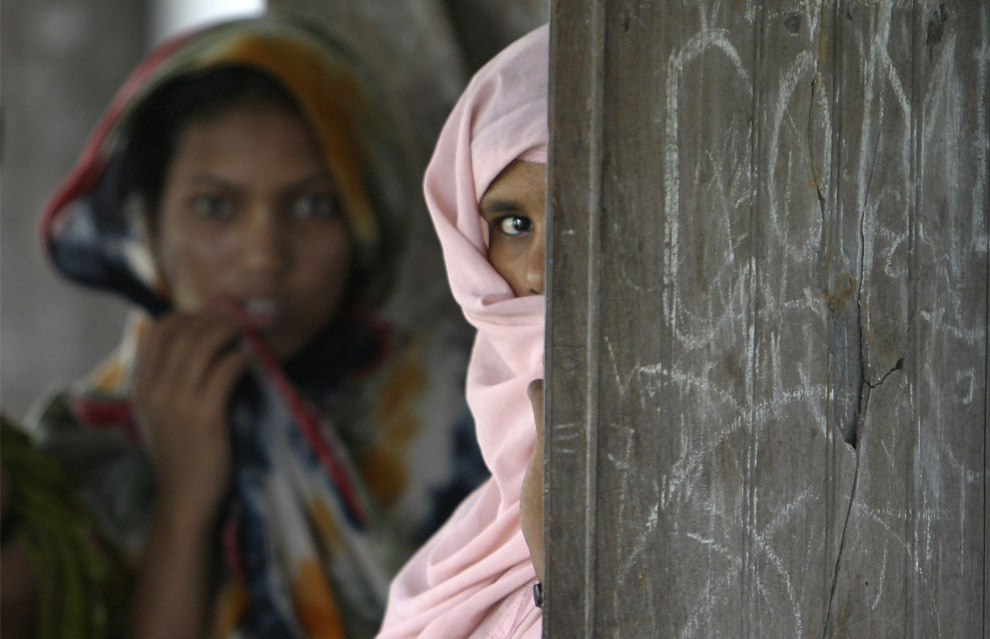
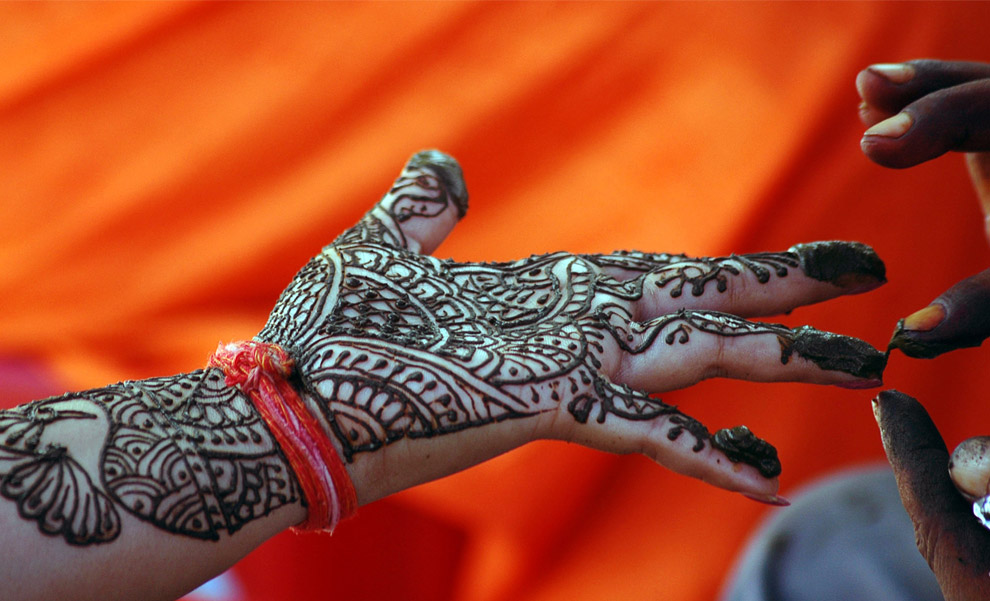
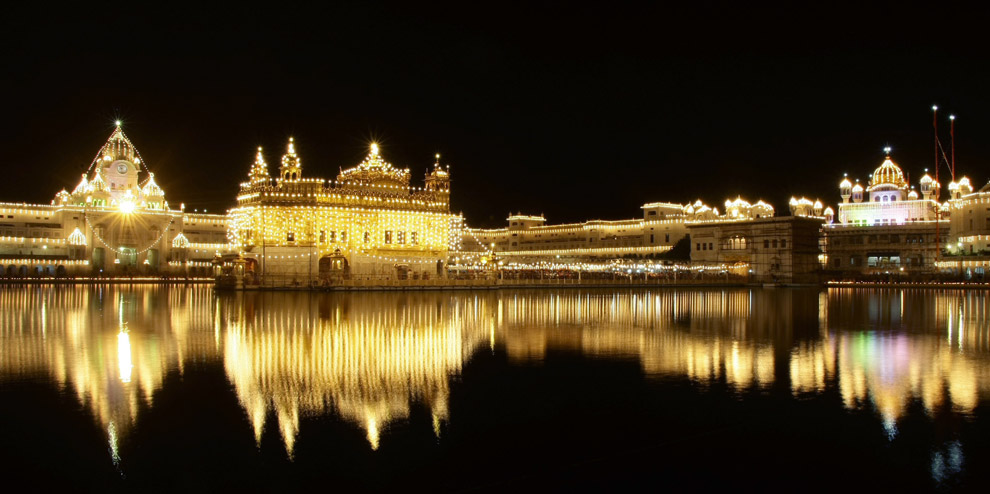

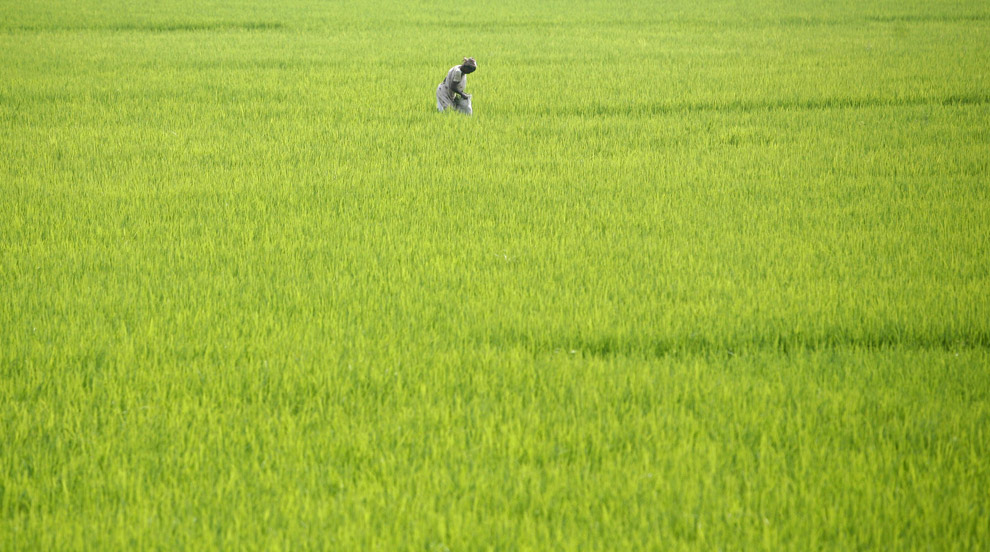
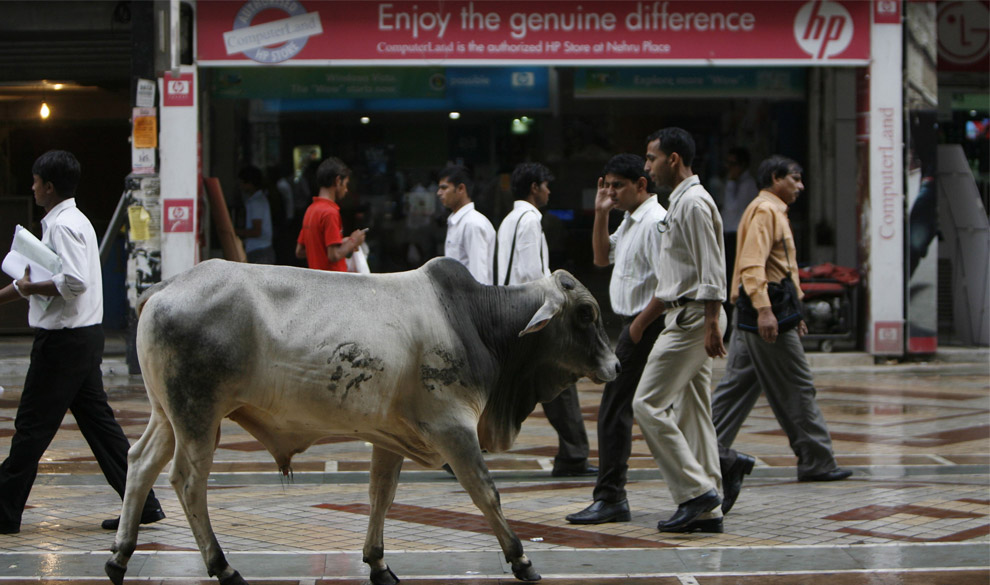

No comments:
Post a Comment